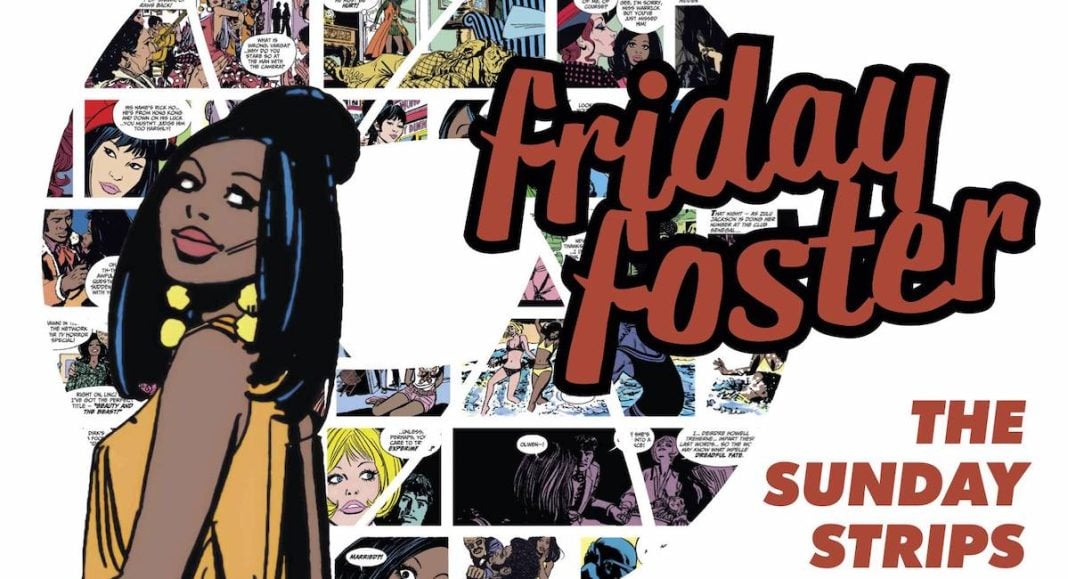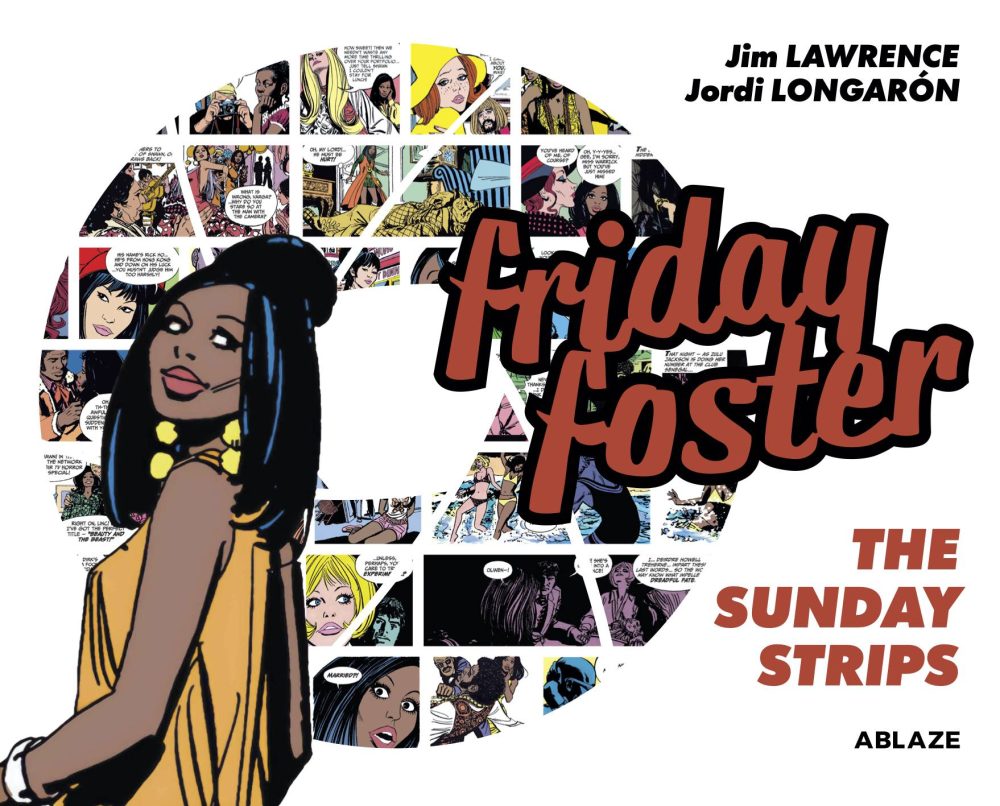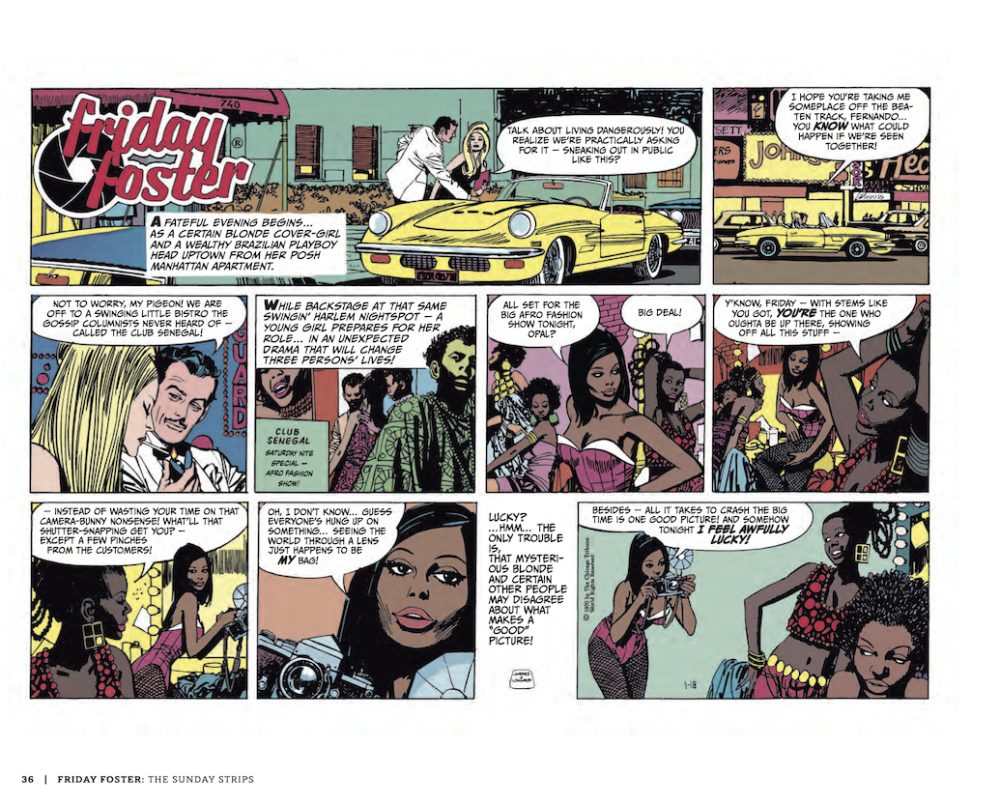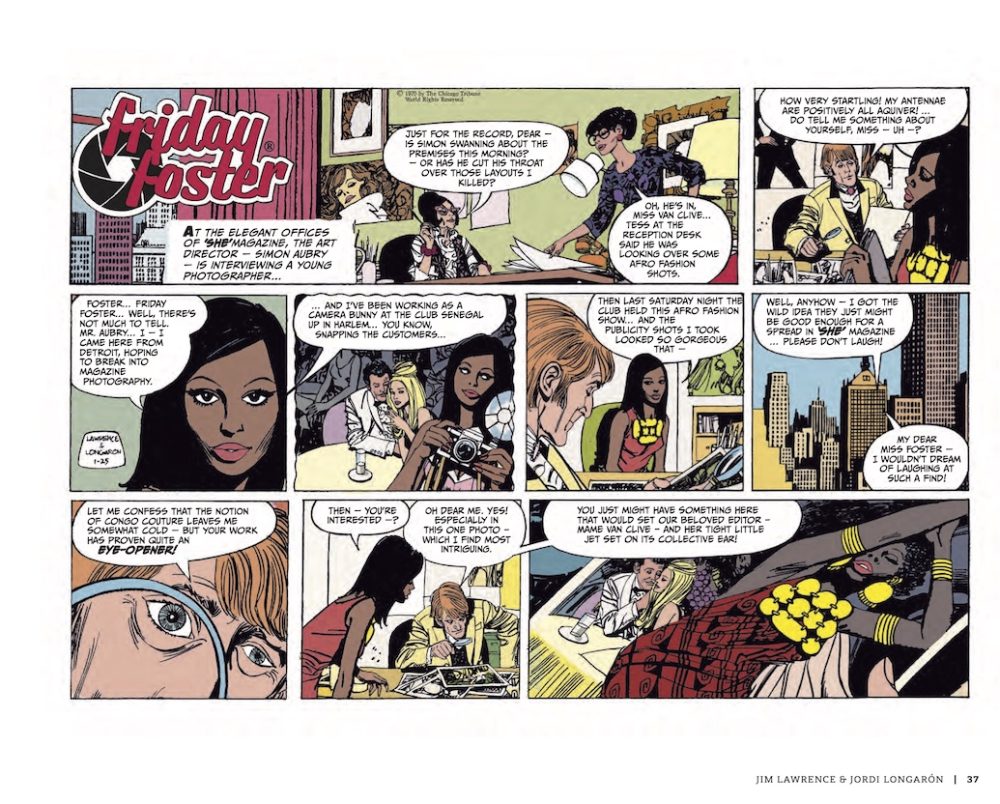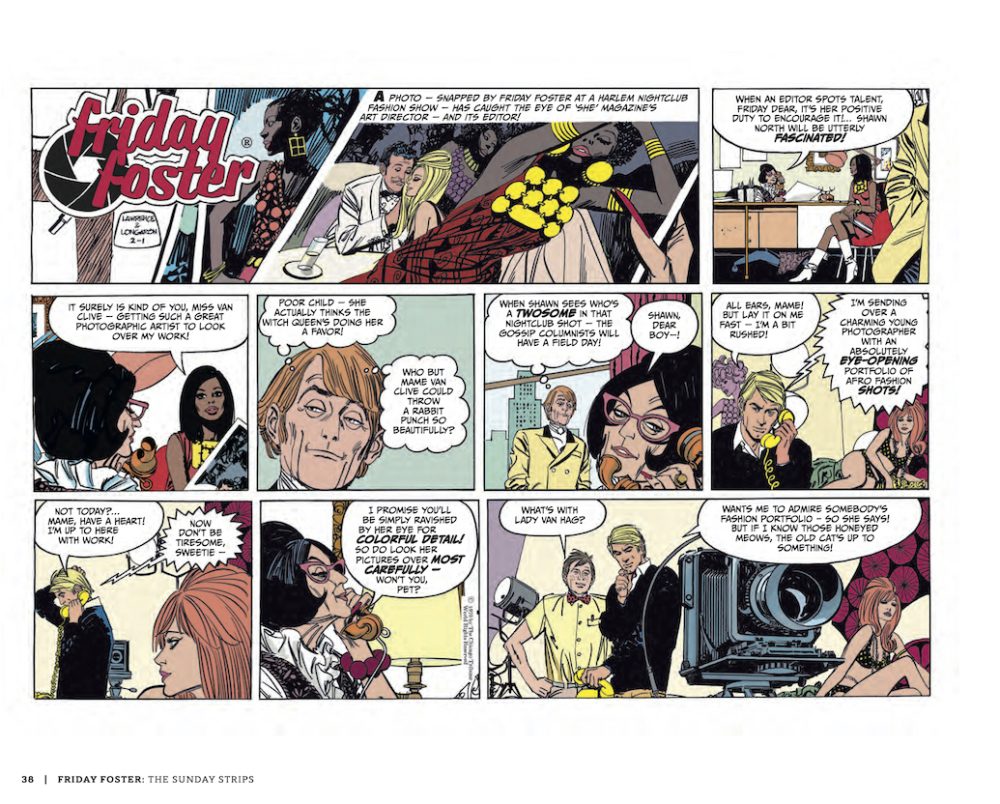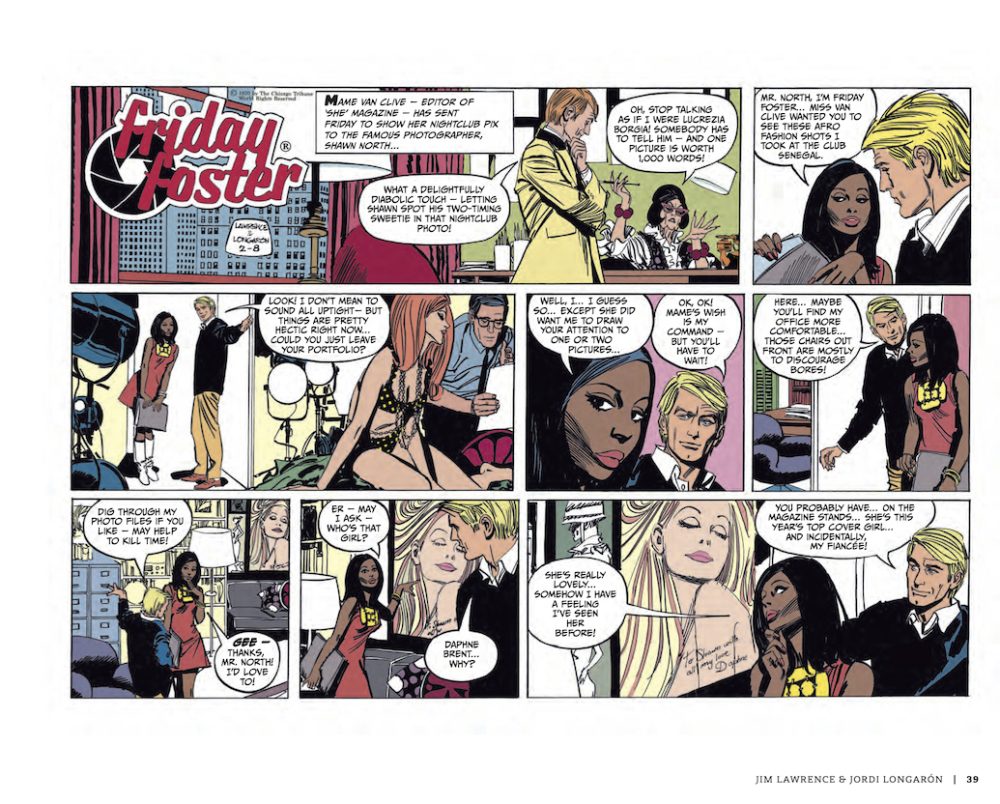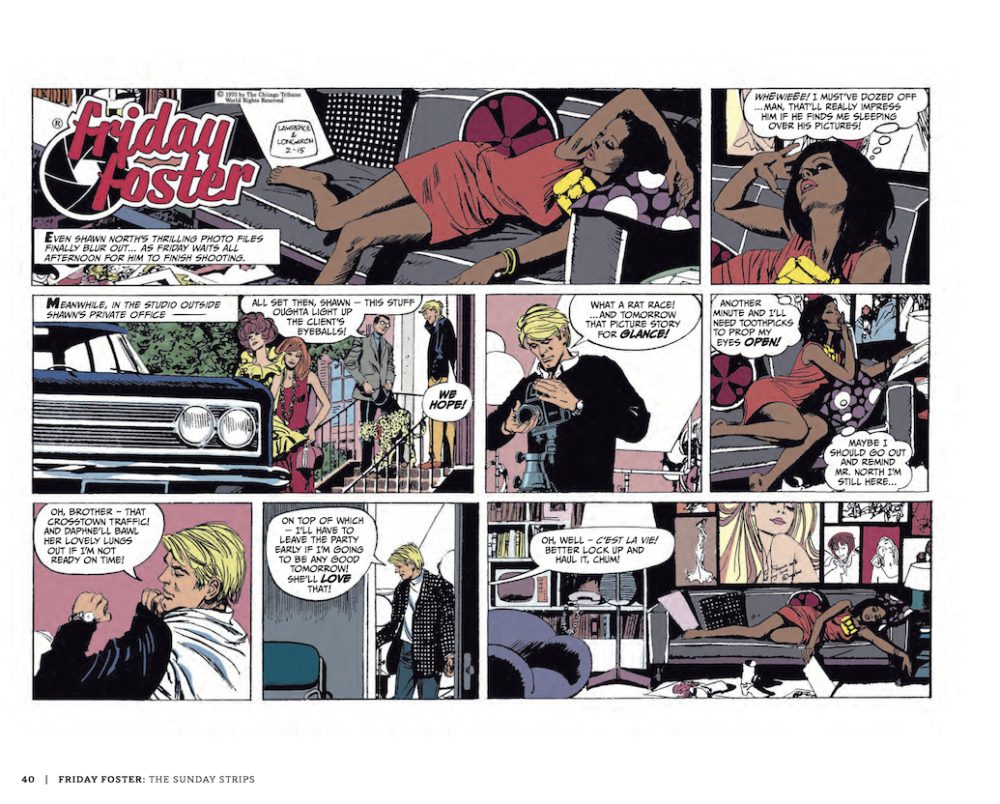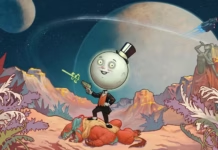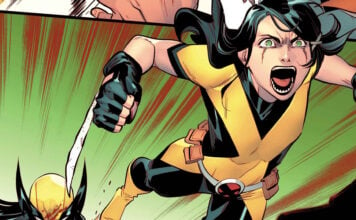Ablaze recently released Friday Foster: The Sunday Strips, a comprehensive hardcover collection of a little-known ’70s comic strip. The inspiration for the film of the same name starring Pam Grier, Friday Foster was the first nationally-syndicated comic with an African-American lead. It was created and written by Jim Lawrence and illustrated by Jordi Longarón during its 1970-1974 run.
This was the first history/archive project for Ablaze, but co-founder Rich Young stated, “While we don’t have any more on the schedule currently, we have been looking at a few other possible projects. So I think I can safely say that you can expect to see more of these from Ablaze in the future.”
Book editor Christopher Marlon answered a few questions via email about the book and how it came to be.
Johanna Draper Carlson: Can you fill us in on your background and what let you to put this book together?
Christopher Marlon: I’m a native Houstonian, and I’ve been in L.A. for the past 19 years chasing the Hollywood dream as a filmmaker. Wow! I can’t believe it’s been that long. I also worked in banking in New York before going to film school in Miami (The U). I like to joke that I’ve made a bunch of short films that most people haven’t seen. And I’m currently seeking completion funding for my feature length documentary, Ophelia’s Influence, about America’s first black fashion model.
After seeing the Friday Foster film about 6 years ago, I was somewhat intrigued by it due to its tonal differences from most blaxploitation pics. I started reading more about the film and discovered that it was based on a comic strip. Shocker! I started researching the comic strip and really got into the stories and loved the artwork!
I used to collect comic books as a kid and have somewhat started to collect again as an adult, which led me to collecting the newspaper strips that weren’t so easy to find. The more I collected, the more I became dedicated to collecting all the Sunday strips. I only collect the Sunday strips because they are in color and a larger format than the daily strips, and the plot turns occur in the Sunday editons. Then I started wondering if the strips had ever been collected into a book, à la The Boondocks.
When I found they hadn’t, I made a promise to myself that I would at least try to see if I could get the (Sunday) strips printed in book form. Then I went to work: finding the point man at the Chicago Tribune (Thanks Scott Cameron), then finding a publisher at their behest as a requirement (Thanks again Rich and Ablaze), researching and corralling the players for the extra features that I wanted (I knew the book had to include more than just the strips), then connecting the two all while I continued to add to my collection — another stipulation of the deal, since the Tribune wasn’t going to supply the strips, oddly enough. I have collected the majority of the 200+ newsprint Sunday strips. The last five months of the run are very difficult to find however, and I only have a few of those, the rest are black and white copies. It’s been over four years since I started this literary journey for my first book, but we are finally at the finish line. I can’t wait for the world to see the book!
Draper Carlson: What’s the appeal of the series, and why should people read the book?
Marlon: For me personally, there is an element of nostalgia. As a child of the 70s, the strips are a very romanticized look at a bygone decade, a sort of throwback to my childhood (even though the strip technically came out before I was born). If you are a fan of the 1970s, the book will be a starry-eyed stroll down memory lane.
In a more general sense, if you enjoy comic art, you can’t lose with Jordi Longarón. His almost photorealistic renderings of the characters and the fashions of the time are truly impeccable. I recently tried to buy one of his Friday Foster originals at an online auction and was easily outbid at $2K. So, fifty plus years after the strip’s debut, there is still quite a demand for his work.
Draper Carlson: The book’s comprehensive introduction mentions your discovery of the comic because of the movie. What are the key similarities and differences between the two?
Marlon: As I mentioned earlier, as a blaxploitation film, the movie is noticeably different from its brethren in that there are moments of levity and light comedy — not something usually associated with the genre — which I like. One noticeable difference between the strip and movie is that you never see Shawn North in the film. Friday has a phone conversation with him at the opening, but after that it’s strictly her story.
There are other characters from the strip in the movie such as investigator Colt Hawkins, millionaire Blake Tarr, and Cleve, Friday’s little brother, but beyond that they don’t share much DNA and the movie still works. Critics don’t necessarily love it as one of Pam Grier’s better soul cinema pics, but I think it puts a nice twist on the genre in terms of storyline. And the movie has a cadre of black talent at the time: Scatman Crothers, Eartha Kitt, Ted Lange, Carl Weathers, Yaphet Kotto, Thalmus Rasulala, and Godfrey Cambridge. (And Jim Backus was sorely underused as a baddie, in my opinion.) It’s amazing how many black actors of the day that are in the film — especially when considering that a lot of fans of the genre haven’t seen it.
Draper Carlson: What did Jim Lawrence get right about writing a black woman? What would be done differently today?
Marlon: To me, it’s quite apparent that James Lawrence was a fairly liberal white guy. First, as a journeyman in the comic strip industry, he saw a gap in the marketplace and took it upon himself to fill it. The fact that he didn’t buy into tropes of the tragic, downtrodden, woe-is-me minority is a great start. But then again, would newspapers even run a strip with that narrative?!
He created Friday as a woman of the times, with professional goals and ambitions, going from nightclub camera girl to being a photog’s assistant to becoming a high-end fashion model. He crafted her as very attractive and likable (men frequently sought her company), and he even styled her as a brave and curious young woman which sent her on whirlwind adventures. These are all the traits you’d see in any comic strip protagonist, which typically would have been white at the time. Think Brenda Starr.
I’d say now the primary difference might be to include a black co-creator on the project. In today’s times of inclusion and diversity, it would be wise to consult with black women at a minimum or work with a black woman in the process of creating said character. It never hurts to go directly to the source.
Draper Carlson: What does Friday Foster have to say to today’s reader?
Marlon: Though the strip was written and set in the 1970s, Jim Lawrence was a very world-wise man and adeptly addressed many issues of the day that still resonate now. There are story arcs that look at issues of women’s body shaming, the feminist movement, the paparazzi-celebrity relationship, cheating lovers, child custody, family money spats… and the list goes on. The stories are by no means “downers”, but they manage to address real life conflicts in a very captivating and timeless manner.
Draper Carlson: With all the extras and the thorough coverage — interviews with the creators, pitch material, unpublished strips, etc. — it’s clear this was a labor of love. Are you planning any other books on comic history?
Marlon: You are right! Labor of love is an understatement, but I’m SO glad I did it! Working on the book has been an absolute joy and worth every minute!
I also started collecting another strip a few years ago called Dateline Danger! It’s another action strip from the late 1960s that ran into the early 70s which also featured a black lead character. There are two leads, one white and one black, and the strip was apparently inspired by the 60s tv show I Spy. The strip ran a little longer than Friday Foster, and I only have a few of them. I haven’t started my research yet, but that might be another undertaking.
Also, Jim Lawrence Jr., the creator’s son, has asked me about doing a book for the Dallas comic strip. Yes, that Dallas, the 80s primetime soap, also had a newspaper comic strip that his father wrote for its entire run. But that’s an early conversation.
Lastly, I would LOVE to produce an animated version of Friday Foster! I think it would make for an awesome tv show. I’ve contacted the tv/film rights holder (not the Chicago Tribune interestingly enough), and they are playing hard ball on making a deal, but hope springs eternal. Long Live Friday Foster!
From Ablaze Publishing, Friday Foster: The Sunday Strips is available now.

